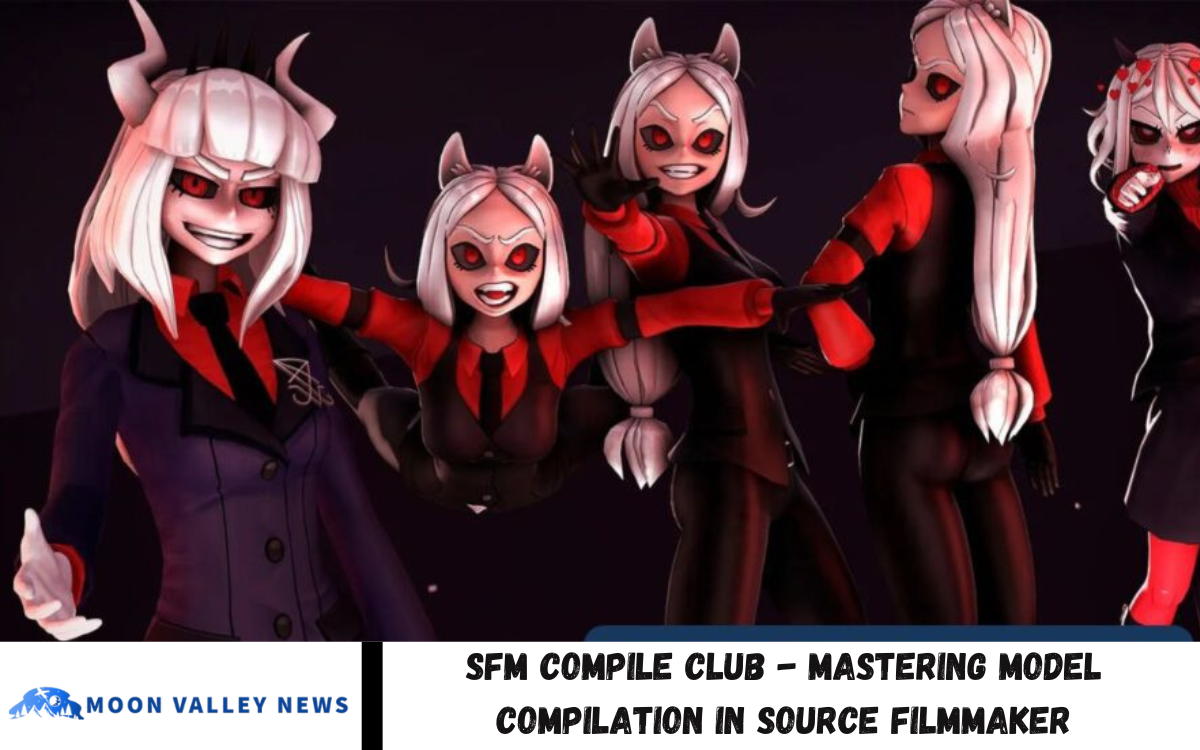SFM Compile Club is a dedicated community for mastering model compilation in SFM, a powerful tool used for creating animations and cinematic projects within the Valve Source engine. Whether you’re a beginner learning the basics or an experienced modder looking to refine your skills, this club serves as the ultimate resource hub for understanding model compilation, rigging, textures, and troubleshooting common issues.
Model compilation in SFM involves converting 3D models into a format that the engine can read and animate. This process includes handling QC files, materials, bones, and hitboxes, ensuring smooth integration into SFM. The club provides tutorials, guides, discussions, and troubleshooting support to help users navigate challenges like missing textures, broken rigs, and export errors.
By joining the SFM Compile Club, members gain access to a collaborative space where they can share knowledge, showcase their work, and receive feedback from fellow creators. Whether you’re working on custom characters, props, or animated sequences, mastering model compilation is key to unlocking SFM’s full potential.
What is SFM Compile Club?
SFM Compile Club is a community dedicated to helping creators master model compilation in Source Filmmaker (SFM). Whether you are a beginner learning how to import custom models or an experienced user troubleshooting complex issues, this club provides valuable resources, guides, and discussions on compiling 3D models for SFM.
Model compilation refers to the process of converting raw 3D assets into a usable format for animation and cinematic projects. This involves handling QC files, textures, materials, bone structures, physics models, and hitboxes to ensure seamless integration into the Source engine. However, many users face challenges like missing textures, broken rigs, or export errors, making proper compilation knowledge essential.
The SFM Compile Club serves as a hub for learning these techniques, offering step-by-step tutorials, troubleshooting help, and expert advice on common problems. Members can also collaborate, share their work, and exchange tips to improve their skills.
Why is Model Compilation Important in SFM?
Model compilation is a crucial step in SFM because it converts raw 3D models into a format that the Source engine can read, animate, and render correctly. Without proper compilation, models may appear broken, missing textures, or fail to load entirely in SFM.
Here’s why model compilation is essential:
Converts Models for Engine Compatibility
SFM requires models to be in.MDL format, which means raw 3D files (e.g., .OBJ, .FBX, .SMD) must be processed using QC files and compiled with tools like Crowbar. This ensures the model is structured correctly for the Source engine.
Ensures Proper Rigging and Animation
For characters and props to function correctly, they need appropriately compiled bones, weights, and animations. Without this, models may appear stiff, deform incorrectly, or fail to animate at all.
Handles Textures and Materials
Model compilation links textures and materials to the model, ensuring proper shading, reflections, and transparency. Without it, models may load with missing or incorrect textures.
Adds Physics and Collision Properties
Compiled models can include collision models (hitboxes) and physics properties, which are essential for realistic interactions in animations or gameplay.
Prevents Common Errors and Glitches
Many issues, such as missing textures, broken meshes, and model distortions, stem from improper compilation. Understanding the process helps fix these problems and improve workflow efficiency.
Allows Customization and Optimization
Proper compilation enables custom characters, props, and accessories to be fully functional in SFM, allowing creators to expand their animation possibilities. Additionally, well-compiled models reduce file size, improve performance, and prevent crashes.
By mastering model compilation, SFM users gain greater control over their assets, ensuring high-quality visuals and smooth animations. This is why SFM Compile Club exists—to help creators navigate and master this essential skill!
Key Components of Model Compilation
Model compilation in Source Filmmaker (SFM) involves several essential components that ensure 3D models function properly within the Source engine. Each component plays a crucial role in how the model appears, moves, and interacts in SFM.
QC File (Compilation Script)
The QC (QuakeC) file is the script that tells the compiler how to process a model. It includes:
- Model file paths and names
- Physics properties (if applicable)
- Texture references (materials)
- Animation and bone settings
- Hitboxes for collision detection
Without a properly written QC file, the model won’t compile correctly.
SMD Files (Model Data)
SMD (Studiomdl Data) files contain different parts of a model:
- Reference SMD – The base mesh of the model
- Animation SMD – Defines movement and rigging
- Collision SMD – Used for physics and hitboxes
These files are converted into the final.MDL format after compilation.
Textures and Materials
Models need textures, which are stored as VTF (Valve Texture Format) files and controlled by VMT (Valve Material Type) files. These define:
- Base colors and normal maps
- Transparency, reflections, and shaders
- Phong shading effects for realistic lighting
If materials are missing or misconfigured, models may appear pink/black in SFM.
Rigging and Bone Structures
The model’s bone structure determines how it moves and animates. Key aspects include:
- Properly weighted vertices for smooth deformation
- Bone hierarchy to allow realistic motion
- Flex animations (for facial expressions) if needed
Bad rigging can result in broken animations or stiff models.
Hitboxes and Physics Models
For collision detection and physics interactions, models need hitboxes defined in the QC file and collision SMD. These control:
- Where the model can be “hit.”
- How it interacts with other objects
- Ragdoll behavior for physics-based animation
Model Compiler (Studiomdl.exe)
This is the official Source engine compiler that processes the QC and SMD files into a final MDL file. It handles:
- Model Optimization
- Texture and material linking
- Physics and collision integration
Using tools like Crowbar simplifies this process.
File Organization and Directory Structure
All files within the SFM custom model directory should be structured correctly for proper compilation. Incorrect file paths can cause models or textures to not load properly.
Mastering these key components—QC files, SMD files, textures, rigging, hitboxes, and compilation tools—is essential for creating high-quality, custom models in Source Filmmaker. The SFM Compile Club helps users navigate and perfect these aspects, ensuring their models integrate smoothly into SFM.
Read Also: A Comprehensive Guide to Greblovz2004 – An In-Depth Look
Tools and Software for Model Compilation
Model compilation in Source Filmmaker (SFM) requires several essential tools to convert, edit, and compile 3D models for use in the Source engine. Below is a list of the most commonly used software for this process.
Crowbar
- A decompiler and compiler for Source models.
- Allows users to extract, edit, and recompile models for SFM.
- Supports QC file editing and batch compiling.
Blender
- A powerful 3D modeling and animation software.
- With the Source Tools add-on, models can be exported to SMD format for compilation.
- Supports rigging, texturing, and animation for SFM models.
Autodesk 3ds Max
- A professional 3D modeling tool with Valve Source engine support.
- Can export SMD files using the Wallworm plugin.
- Used for high-quality character and prop modeling.
VTFEdit
- Converts standard image formats (PNG, JPG, TGA) into VTF (Valve Texture Format).
- Allows editing and converting textures for SFM models.
- Works alongside VMT (Valve Material Type) files to define shader properties.
Notepad++
- A lightweight code editor useful for editing QC files.
- Provides syntax highlighting and better readability than basic text editors.
- Helps in debugging compilation scripts.
HLMV (Half-Life Model Viewer)
- A tool for previewing compiled.MDL files before using them in SFM.
- Allows checking textures, bones, animations, and hitboxes.
- Helps troubleshoot model issues before final use.
StudioMDL
- The official Source engine model compiler.
- Processes SMD and QC files into MDL format.
- Often used through Crowbar for an easier workflow.
GCFScape
- A tool for extracting models, textures, and assets from Valve game files.
- Useful for modders who want to edit existing Source engine models.
VTFLib
- A command-line tool for batch processing and converting textures to VTF format.
- Helpful in automating large texture imports.
Source SDK
- The official development kit for Source engine tools.
- Includes Faceposer, Hammer Editor, and other utilities for advanced customization.
- Helps in creating complex animations and physics models.
These tools are essential for compiling, editing, and troubleshooting models in SFM. Mastering these software tools will streamline the model compilation process, whether you’re creating new models, rigging characters, or fixing texture issues. The SFM Compile Club provides guidance on using these tools effectively to help users create high-quality models for Source Filmmaker.
Frequently Asked Questions
Why does my model appear broken or distorted in SFM?
Incorrect bone weights, bad rigging, or export errors often cause this issue. Check if the model is correctly weighted in Blender/3ds Max, and ensure the correct SMD file format is used for compilation.
How can I add physics and hitboxes to my model?
Physics models and hitboxes are defined in the collision SMD file and referenced in the QC file using $collisionmodel or $collisionjoints. These allow for ragdoll physics and collision detection in SFM.
Can I compile models from other games into SFM?
Yes, but you must extract, convert, and recompile them properly. Tools like GCFScape and Crowbar can help decompile game models, but always ensure you follow legal and copyright guidelines.
What are common errors during model compilation, and how do I fix them?
- “Too many vertices” error – Reduce model complexity or split into multiple parts.
- “Model not found” error – Ensure the compiled.MDL file is in the correct SFM directory.
- “QC error: unknown command” – Check for typos or missing parameters in the QC file.
How can I join the SFM Compile Club and improve my skills?
You can join online communities, forums, or Discord groups focused on compiling the SFM model. Engaging with tutorials, asking questions, and sharing your work will help you learn faster and troubleshoot issues effectively.
Conclusion
Mastering model compilation in Source Filmmaker (SFM) is an essential skill for anyone looking to create custom characters, props, and animations within the Source engine. The process involves handling QC files, SMD formats, textures, rigging, hitboxes, and physics models, ensuring seamless integration into SFM.







